Jacobs Institute for Design Innovation
Project Overview
“Design innovation starts with asking the right questions and ends with changing the world.”
- Jacobs Institute Mission Statement
Founded on the conviction that design can help address some of society’s most pressing challenges, the Jacobs Institute for Design Innovation at UC Berkeley, is devoted to introducing sustainable design innovation at the center of engineering education and university life. The project was conceived by the College of Engineering as an interdisciplinary hub for students and teachers from across the university who work at the intersection of design and technology. It is designed as both a collaborative, project-based educational space and a symbol to the region of the University’s commitment to sustainable innovation.
The tiny corner site, formerly a volleyball court, lies at the northern edge of campus within a dense, diverse context. Two 4-story engineering buildings border the site on the west and south. Single family residences and apartment buildings line the street to the north. An existing two-level basement lies directly beneath 35% of the site.
The program, intended to accommodate up to 2,000 students per semester, includes flexible design studios, project rooms, support spaces and fabrication equipment rooms containing a variety of rapid prototyping tools and equipment.
Design & Innovation
The Jacobs Institute’s mission is to expand the role of design in engineering education at all levels, empowering young engineers to create innovative solutions to society’s biggest problems. The architecture reflects this mission, modeling high-density / low-carbon living and learning in spaces that support project-based learning, rapid prototyping and fabrication.
• HIGH DENSITY URBAN INFILL: The project repurposes an underutilized 11,000 SF site, optimizing learning space within a compact 24,035 GSF building. The efficient design minimizes circulation/service space while maximizing flexible learning space. The structure cantilevers 12 feet southward over an existing basement to create sufficient space for the new building while retaining a south-facing courtyard.
• MODELING SUSTAINABLE INNOVATION: The project was envisioned as a striking new threshold to the campus - a “beacon of innovation” expressing the sustainable values of the Institute and the University. The architecture outwardly demonstrates sustainable design innovation, integrating economic strategies that foster practical and poetic connections between students and the natural world.
• ADVANCED ENERGY-EFFICIENCY: The project is designed to exceed the AIA 2030 Commitment target, using 90% less energy than the national median for university buildings. Integrated energy efficiency drives the overall building form and appearance, including simplified massing, high-performance skin and the cantilevered photovoltaic array.
Regional/Community Design
“The Jacobs Institute is UC Berkeley’s interdisciplinary hub for students, teachers and practitioners who work at the intersection of design and technology.”
– Jacobs Institute Mission Statement
The Institute fosters interdisciplinary engagement across the University, welcoming students from other departments, inventors, tinkerers and over thirty student clubs to an inspiring environment of creativity and innovation.
• THRESHOLD AND DESTINATION: Located at the northern edge of campus, the building serves as a new threshold to the University and a “beacon of innovation” attracting students at all hours. A cantilevered photovoltaic array ascends to the north, expressing the aspirational values of the Institute to the University and the public. Glassy stairs project outward, glowing after dark to welcome visitors.
• TRANSIT-ORIENTED: The new building provides no parking except for one wheel-chair accessible street parking space. Access to the building is by foot, bicycle and public transit. Walk Score Rating: 86.
• TRANSPARENCY: The design emphasizes transparency and overlooks to reveal the hum of creative activity to the University and the community. The south wall opens to the sun for daylighting and passive solar benefit while connecting to outdoor terraces.
• STABILITY: The seismic system exceeds the California Building Code for added resilience.
Metrics
Land Use & Site Ecology
The new building is an urban infill project within a dense campus / community context. It repurposes previously developed land and enhances environmental quality on a constricted site.
• DENSIFYING DEVELOPED LAND: The project converts a tiny 11,000 SF site – formerly an underused volleyball court – that is partially underlain by an existing two-story basement. To maximize buildable area on the tight site, the structure cantilevers 12 FT over the existing two story basement. Remaining site resources are arranged efficiently to provide benefits to students and the environment.
• SOUTH COURT: The roof of the existing basement is reused as a south-facing courtyard that solves fire separation requirements, enhances solar and natural ventilation access, provides pedestrian access across the site, and creates a sunny outdoor space for classes to use in warm weather.
• SITE ECOLOGY: The 1,450 SF landscaped area along the north property line serves several purposes as well. It works with the new building to transition the institutional campus scale to the residential scale of the community. Planted with draught-tolerant landscaping and Incense Cedars, this area preserves habitat for native birds and other species. It also serves as a bio-swale / rain garden that filters all roof drainage before it enters the storm drainage system.
Bioclimatic Design
The site is located in the warm, marine climate of the Northern California inland coastal region. Adjacent Soda Hall steps up to the south away from the site, affording excellent solar access. Four story Etcheverry Hall to the west of the site partially shields the site from seasonal winds and the low western sun. The building fully engages this climate and site, benefitting from natural systems while connecting students to the daily rhythms of the sun and the changing seasons unique to their place.
• ORIENTATION: The building is oriented on an east-west axis for optimal solar benefit. This creates a wind-protected, sunny courtyard to the south while enhancing building access to passive solar heating, daylighting, natural ventilation and a continuum of indoor / outdoor spaces at the first floor.
• COMPACT MASS: A compact building mass with an efficient skin-to-floor area ratio helps to reduce thermal transfer. A narrow, 55 ft. deep floorplate and 14 ft. ceilings, promote excellent natural ventilation and daylight penetration.
• HIGH-PERFORMANCE ENVELOPE: A highly insulated envelope, with exterior insulation, rain screen cladding and integrated sun-shading on three exposures, manages external building loads. Energy Star-rated cool roofing and high-albedo paving help to further reduce cooling loads in warm weather.
Light & Air
The design emphasizes simple solutions that maximize energy efficiency, user comfort and biophilic connections to nature while reducing first cost and long-term maintenance.
• DAYLIGHT: The narrow building floorplate presents a shaded façade to the south for optimum daylight harvesting. Large north-facing windows and interior glazing help to reduce internal glare. 100% of instructional spaces above the basement and 85% of all regularly occupied spaces are day-lit.
• BIOPHILIC BENEFITS: The biophilic benefits of daylight were also considered in the design, ensuring that public spaces are enlivened throughout the day.
• VIEWS: Transparency is a key strategy used to promote a healthy learning community and individual well-being. 100% of instructional spaces above the basement and 85% of all regularly occupied spaces enjoy views to the outdoors.
• AIR: The building opens to the prevailing winds, allowing 100% of instructional spaces above the basement level and 85% of all regularly occupied spaces to be naturally ventilated. Mechanical ventilation provides added fresh air when windows are closed, providing 30% additional outside air above code requirements. Material selection, including no-VOC paints, adhesives and sealers, formaldehyde-free materials, etc., ensures healthy indoor air quality. IAQ Management Plans were implemented during the construction and pre-occupancy periods.
Metrics
Water Cycle
Located in a semi-arid climate that experiences periodic droughts, the project reduces total potable water use by 50% and treats 100% of roof drainage on the small, constricted site.
• BUILDING WATER USE: Ultra-low flow fixtures reduce building water consumption by 50% from baseline.
• LANDSCAPE WATER USE: Drought-tolerant landscaping, sub-surface drip irrigation systems and advanced, weather-based irrigation controllers combine to reduce landscape water use by 50% from baseline. The small size of the site’s landscaped area makes efficient use of available land while further reducing water consumption for landscaping.
• STORM WATER MANAGEMENT: 100% of the project’s roof drainage is piped from the south to the small, 1,400 SF northern landscaped area, where it is delayed, absorbed and filtered by a bio-swale and rain garden. Excess filtered stormwater is delivered to the city storm sewer.
Metrics
Energy Flows & Energy Future
The project exceeds the AIA 2030 Commitment target, using 90% less energy than the national median for university buildings per EPA Target Finder.
• HIGH-PERFORMANCE ENVELOPE: The thermally-broken envelope integrates added insulation, sun shading, cool roof, high-performance glazing and daylighting to reduce heating, cooling, and lighting loads.
• VENTILATION: The building is naturally ventilated, augmented by code-required mechanical ventilation in internal areas and the basement. 30% more outdoor air than ASHRAE standards is provided to enhance indoor air quality when windows are closed.
• THERMAL COMFORT: Space heating is provided by hydronic radiators, augmented by tempered mechanical ventilation air. Cooling is provided by natural ventilation and ceiling fans, augmented by “bump cooling” delivered by the mechanical system.
• ENERGY PIGGYBACK: The building utilizes surplus hot and chilled water for space conditioning from adjacent Soda Hall, saving the cost, embodied energy and space required to generate these resources onsite.
• LIGHTING: Although the University required higher than normal interior light levels of 50 foot-candles due to the fine-scaled work occurring in the spaces, total lighting loads were managed through the use of efficient fixtures and controls.
• RENEWABLE ENERGY: A cantilevered 74kW photovoltaic array, celebrated as a signature architectural element, provides 58% of the building’s energy requirement.
Metrics
Materials & Construction
Multiple design strategies model respect for natural resources.
• RESOURCE REDUCTION: The building and site work were “right-sized” to fit on the tight urban site. Material use was reduced through the design of simple forms using a straightforward structural system and conventional manufacturing dimensions.
• MATERIALS: Materials were selected for economy, durability, and resource efficiency. 17% of all building materials are recycled, including 50% fly ash content in foundation concrete and floor slabs, carpet, and steel. Aluminum was required to have 50% recycled content. 12% of all materials were regionally harvested and manufactured to reduce embodied energy and carbon footprint associated with shipping. 75% of all wood products are FSC-certified. Rapidly renewable materials include rubber flooring and base, linoleum flooring, and agrifiber door cores.
• HEALTH: Materials were researched and selected to ensure healthy indoor environments, including no-VOC, vinyl-free and formaldehyde-free products. IAQ Management Plans were implemented during the construction and pre-occupancy periods, including a two-week building flush-out.
• WASTE REDUCTION: 1,595 tons (97%) of site and construction debris was recycled and diverted from landfills. Recycling and composting stations throughout the building promote ongoing waste management.
Long Life, Loose Fit
The steel and concrete building was designed for a minimum useful life of 100 years.
• RESILIENCE: Located in a seismically active region, the building was designed to meet University seismic requirements that exceed the California Building Code in order to enhance life safety and minimize damage in a seismic event. Strategies included the use of simple, self-bracing building forms and high-efficiency seismic systems.
• DURABILITY: Major finishes were selected for durability, low maintenance and fire resistance. The primary exterior finishes are concrete and metal panels. Primary interior finishes - polished concrete floors and painted drywall - are easily maintained with light cleaning and paint.
• FLEXIBILITY: The building was designed to provide flexibility in both short and long terms. In the short term, teaching spaces are easily adaptable to evolving curricula and technologies. To the greatest extent possible given the specialized nature of the program, spaces were generalized to allow for future adaptation to unforeseen alternative uses in the long term.
• ADAPTABILITY: If the College of Engineering decides to relocate at some point in the future, the building could easily be converted to another use beneficial to the University. .
Collective Wisdom & Feedback Loops
• DESIGN DIALOGUE: The Design Team engaged the College of Engineering and University representatives in focused workshops addressing sustainability, comfort, operability and maintenance throughout the design phases. This helped to solidify low-energy strategies early in design while also managing occupant expectations.
• ENERGY MODELING: A project goal of exceeding the AIA 2030 Commitment target was established at the first owner and consultant meetings. The energy model was updated frequently throughout the design phases to confirm compliance with this goal.
• RENEWABLE ENERGY: Due to budget constraints, the renewable energy system was held out of the base project scope and funded late in construction solely due to the efforts of the Assistant Dean of the College of Engineering.
• ENERGY PERFORMANCE: Based upon the University’s online energy performance monitor, the building has performed consistently with predictions for the first 4 months of occupancy.
• POST-OCCUPANCY EVALUATION: The project has been operational for 4 months. A POE through UC Berkeley’s Center for the Built Environment is planned for the near future.
LESSONS LEARNED:
• Establish and document energy goals and performance expectations early in design
• Integrate energy and thermal comfort modeling closely with the design process
• Committed individuals can have a profound impact on project success!
• Extended post-occupancy monitoring and system adjustment is critical to meeting advanced energy goals.
Other Information
The Owner wished to maximize sustainable design benefits while using readily-available, simple and cost-effective methods. A cost and payback analysis was not required.
The project process comprehensively engaged all design team members and the community in all phases.
PRE-DESIGN:
• The design team undertook a detailed analysis of the site micro-climate and historic ecologies prior to the start of design.
• Design workshops with school administration and user groups identified energy-efficiency, thermal comfort, resource-efficiency and building health goals.
DESIGN:
• Focused student and faculty design discussions were held at key project milestones.
• A detailed Building Performance Narrative was prepared and presented to the Owner for approval early in the design phase. This document defined project energy and resource efficiency goals, as well as the anticipated thermal comfort ranges, helping to confirm user buy-in and future expectation.
MEASUREMENT & VERIFICATION / POST-OCCUPANCY EVALUATION
• The project has been occupied for five months and Post Occupancy Evaluation is on-going. Thus far it has included interviews with faculty and facility staff, as well as preliminary review of initial energy use data.
Additional Images
Project Team and Contact Information
| Role on Team | First Name | Last Name | Company | Location |
|---|---|---|---|---|
| Owner's Representative | Ken | Defiebre | KSD Group | Concord , CA |
| Structural Engineer | Mason | Walters | Forell/Elsesser | San Francisco, CA |
| Landscape Architect | Cliff | Lowe | Cliff Lowe Associates | San Francisco, CA |
| Mechanical, Plumbing, Fire Protection Engineer (Basis of Design) | Tyler | Bradshaw | Integral Group Engineers | Oakland, CA |
| Electrical Engineer (Basis of Design) | David | Kaneda | Integral Group Engineers | San Jose, CA |
| Civil Engineer | John | Lamon | BKF | Pleasanton, CA |
| Acoustical Consultant | Charles | Salter | Charles M. Salter Associates | San Francisco, CA |
| Decorative Panel Design Concept | Anne | Thompson | UC Berkeley Student | Berkeley, CA |
| Specifications Consultant | Richard | Fiory | Topflight Specs | San Francisco, CA |
| Lighting Consultant | David | Malman | Architectural Lighting Design | San Francisco, CA |
| Surveyor | Walter | Stemberga | BKF | Pleasanton, CA |
| Telecommunications Consultant | Justin | Mehtlan | McMillan Data Communications | San Francisco, CA |
| Security Consultant | Manny | Monje | Siemens Industry, Inc. | Hayward, CA |
| Waterproofing Consultant | Ken | Klein | Simpson Gumpertz & Heger | San Francisco, CA |
| Cost Estimator | David | Cobb | Davis Langdon / AECOM | San Francisco, CA |
| Arborist | Jim | Clark | HortScience | Pleasanton, CA |
| Code Consultant | Jared | Mattern | Rolf Jensen | Walnut Creek, CA |
| Commissioning | Darren | Goody | Facility Dynamics Engineering | Happy Valley, OR |
| Contractor and Construction Manager | Pat | Callahan | Hathaway Dinwiddie | San Francisco, CA |


















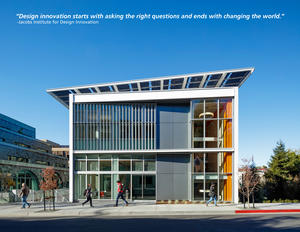
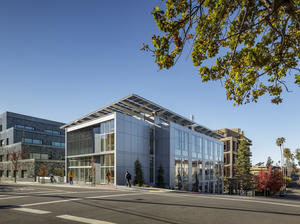
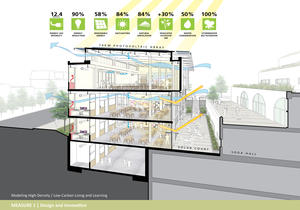
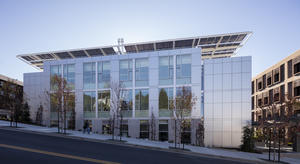
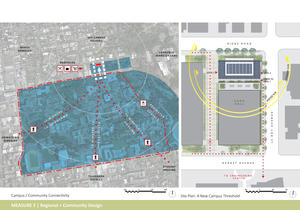
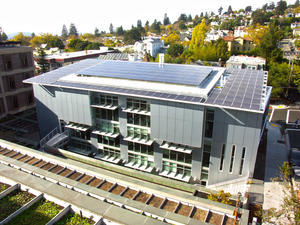
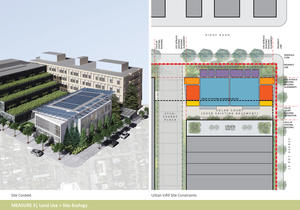
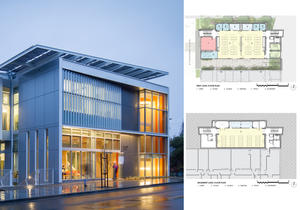
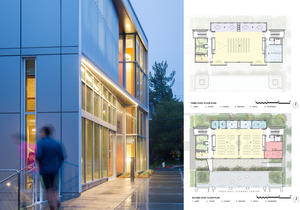
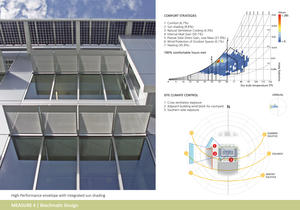
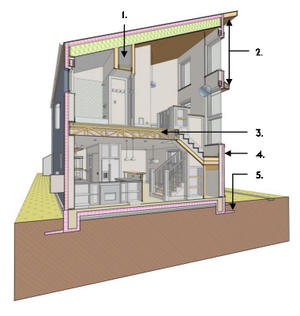
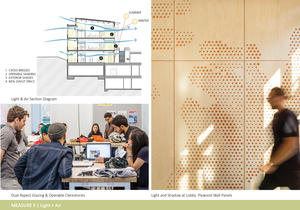
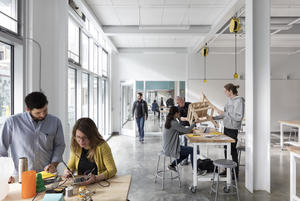
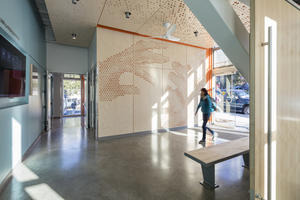
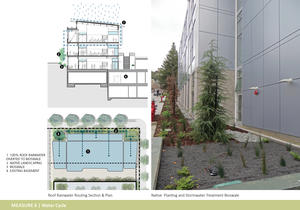
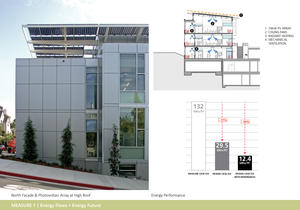
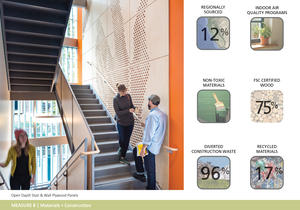
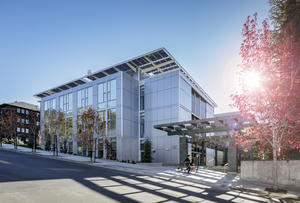


A compact, elegant building with a clear point of view. Sustainable measures are well integrated into a holistic, high-quality design. Modest, beautifully detailed; the building really fits the context of the university.